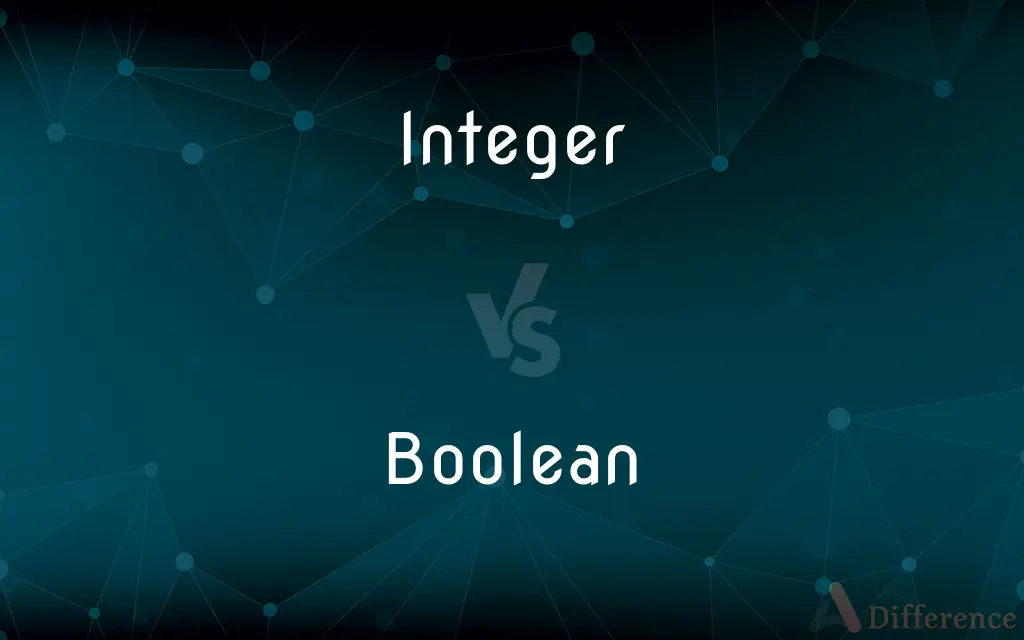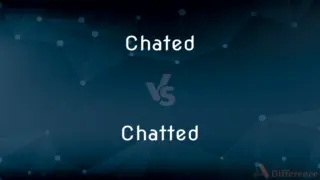Integer vs. Boolean — What's the Difference?
By Fiza Rafique & Urooj Arif — Updated on March 20, 2024
Integers are whole numbers that can be positive, negative, or zero, while Booleans represent two possible values: true or false.

Difference Between Integer and Boolean
Table of Contents
ADVERTISEMENT
Key Differences
Integers are a fundamental data type in programming, representing a set of whole numbers including positive numbers, negative numbers, and zero. They are used in various operations, such as counting, indexing, and mathematical calculations, providing a wide range of values to work with. In contrast, Booleans are a data type representing logical values, with only two possible values: true or false. Booleans are primarily used in conditional statements and loops to control the flow of a program based on logical conditions.
The concept of integers originates from mathematics, where they form an integral part of number theory and are essential for various mathematical operations. In programming, integers are used to perform arithmetic operations and to manipulate data. On the other hand, the Boolean data type is named after George Boole, an English mathematician who introduced Boolean algebra. Booleans play a crucial role in decision-making processes in programming, enabling the execution of code based on logical conditions and comparisons.
The range of values for integers depends on the programming language and the system architecture. For example, in a 32-bit system, an integer might typically range from -2,147,483,648 to 2,147,483,647. However, Booleans have a fixed range, representing only two states, which are generally implemented as 0 (false) and 1 (true) in most programming languages, although the actual representation can vary.
In terms of memory usage, integers typically require more storage space than Booleans. For instance, a standard integer might use 32 bits of memory, whereas a Boolean can often be stored in a single bit. However, due to data alignment and memory management practices, the actual memory usage for Booleans might be larger in practice, often using a full byte.
The choice between using an integer and a Boolean depends on the specific requirements of the program. Integers are suitable for scenarios requiring numerical data manipulation, while Booleans are ideal for controlling the flow of the program through logical operations and conditions.
ADVERTISEMENT
Comparison Chart
Definition
Whole numbers including negative, zero, and positive
Logical data type with two values: true or false
Usage
Arithmetic operations, counting, indexing
Conditional statements, loops, decision making
Origin
Mathematics
Boolean algebra, named after George Boole
Value Range
Varies by system (-2^31 to 2^31-1 for 32-bit)
Two values (true, false)
Memory Usage
Typically 32 bits
Often 1 bit, but practically more due to alignment
Compare with Definitions
Integer
Used in arithmetic operations.
Integer variables are used to calculate the sum of two numbers.
Boolean
Named after George Boole.
Boolean algebra forms the basis for logical operations in programming.
Integer
Can be positive, negative, or zero.
In temperature control, integers represent degrees above and below zero.
Boolean
Represents logical states.
The result of a comparison operation is a Boolean value.
Integer
A data type representing whole numbers.
The variable score as an integer can store values like 10, -3, or 0.
Boolean
A binary data type with values true or false.
The Boolean isComplete can either be true or false.
Integer
Varies in range depending on the system.
32-bit systems have a different integer range than 64-bit systems.
Boolean
Controls program flow in conditional statements.
If a Boolean condition is true, execute the code block.
Integer
Essential for counting and indexing.
An integer index is used to access elements in an array.
Boolean
Limited to two values but crucial for decision making.
Booleans determine whether a loop continues to execute.
Integer
An integer (from the Latin integer meaning "whole") is colloquially defined as a number that can be written without a fractional component. For example, 21, 4, 0, and −2048 are integers, while 9.75, 5+1/2, and √2 are not.
Boolean
Any kind of logic, function, expression, or theory based on the work of George Boole is considered Boolean. Related to this, "Boolean" may refer to: Boolean data type, a form of data with only two possible values (usually "true" and "false") Boolean algebra, a logical calculus of truth values or set membership Boolean algebra (structure), a set with operations resembling logical ones Boolean domain, a set consisting of exactly two elements whose interpretations include false and true Boolean circuit, a mathematical model for digital logical circuits.
Integer
A number which is not a fraction; a whole number
Integer values
Boolean
Of or relating to a logical combinatorial system treating variables, such as propositions and computer logic elements, through the operators AND, OR, NOT, and XOR
A browser that supports Boolean searches.
Integer
A thing complete in itself.
Boolean
Of or relating to a data type or variable in a programming language that can have one of two values, true or false.
Integer
A member of the set of positive whole numbers {1, 2, 3, ... }, negative whole numbers {-1, -2, -3, ... }, and zero {0}.
Boolean
Alternative case form of Boolean
Integer
A complete unit or entity.
Boolean
Alternative case form of Boolean
Integer
(arithmetic) A number that is not a fraction; an element of the infinite and numerable set {..., -3, -2, -1, 0, 1, 2, 3, ...}.
Boolean
Of or relating to a combinatorial system devised by George Boole that combines propositions with the logical operators AND and OR and IF THEN and EXCEPT and NOT
Integer
A complete entity; a whole number, in contradistinction to a fraction or a mixed number.
Integer
Any of the natural numbers (positive or negative) or zero
Common Curiosities
How does the range of values for integers and Booleans differ?
Integers have a wide range of values depending on the system, while Booleans are limited to two values: true and false.
What is the main difference between an integer and a Boolean?
An integer represents whole numbers, while a Boolean represents logical values true or false.
Why are integers and Booleans important in programming?
Integers are crucial for numerical data manipulation, and Booleans are essential for controlling program flow based on logic.
Can a Boolean be used instead of an integer?
Booleans are not typically used in place of integers due to their limited range of values. They serve different purposes.
Can the memory usage of Booleans be more than 1 bit?
Yes, due to data alignment and memory management, Booleans might use more memory than a single bit, often a full byte.
Why might an integer require more storage than a Boolean?
Integers require more storage due to their ability to represent a much larger range of values than Booleans.
How can the range of integers affect programming decisions?
The range of integers can influence the choice of data types for variables, especially when dealing with large numbers or system-specific limitations.
Are there programming languages without explicit Boolean types?
Yes, older languages or some low-level languages might use integers for logical operations, interpreting zero as false and non-zero as true.
What happens if I try to use an integer in a Boolean context?
In many programming languages, non-zero integers can be treated as true, and zero as false, in logical contexts.
What is the significance of George Boole in relation to Booleans?
George Boole introduced Boolean algebra, which is the foundation for the Boolean data type in programming.
How are integers used in arithmetic operations?
Integers are used to perform operations such as addition, subtraction, multiplication, and division.
In what scenarios are Booleans particularly useful?
Booleans are useful in scenarios requiring decision making, such as evaluating conditions in if-else statements and loops.
How do Booleans enhance readability in programming?
Booleans can make conditions in programming clearer and more intuitive, enhancing code readability and maintainability.
What is a common misconception about Booleans?
A common misconception is that Booleans can only be used in simple true or false conditions, but they are fundamental in complex logical operations.
Can Boolean values vary between programming languages?
While the concept of true and false is consistent, how Boolean values are represented and used can vary slightly between languages.
Share Your Discovery

Previous Comparison
Chated vs. Chatted
Next Comparison
Dormitory vs. AccommodationAuthor Spotlight
Written by
Fiza RafiqueFiza Rafique is a skilled content writer at AskDifference.com, where she meticulously refines and enhances written pieces. Drawing from her vast editorial expertise, Fiza ensures clarity, accuracy, and precision in every article. Passionate about language, she continually seeks to elevate the quality of content for readers worldwide.
Co-written by
Urooj ArifUrooj is a skilled content writer at Ask Difference, known for her exceptional ability to simplify complex topics into engaging and informative content. With a passion for research and a flair for clear, concise writing, she consistently delivers articles that resonate with our diverse audience.














































